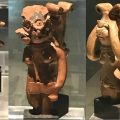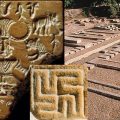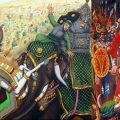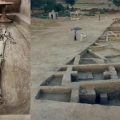Academic Terrorism? JNU Leftists Oppose Webinar on Sarasvati Civilisation
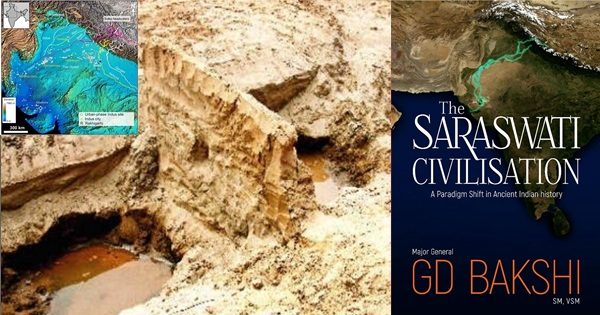
Did River Sarasvati exist? Why does the Rigveda find mention of Sarasvati river at least 50 times if the ancient river hasn’t existed? Why do the left and Communist historians label it as a mythical river? Is it to divert the whole attention of an ancient Indian civilization to only the Indus valley? Is it to justify the Westerners’ fake Aryan Invasion / Migration theory?
JNU is all geared up to organize a webinar on the Sarasvati civilisation, revolving around the book The Sarasvati Civilization authored by Maj Gen GD Bakshi, VSM, SM published by Garuda Prakashan. Maj Gen GD Bakshi has been invited as the speaker. Once the news about the webinar came under the notice of the leftists lobby of JNU, objections were raised. The JNU leftist lobby doesn’t want the webinar to happen unde rthe banner of JNU.
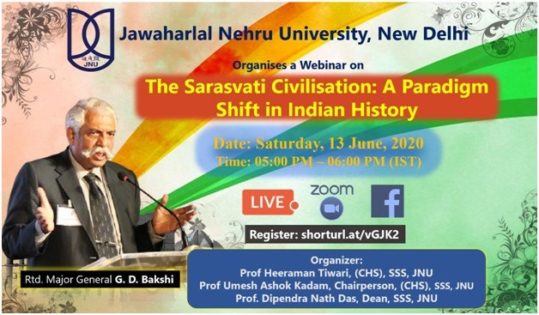
To quote Maj Gen GD Bakshi: ”Academic terrorism?I was Invited by JNU to address a webinar on Sarasvati civilisation- Paradigm Shift in Ancient indian History. The views expressed in my book ( and by Eminent scholars like Dr BB lall) are not acceptable to the Leftist- Marxsist group of students in the JNU. They have demanded that i not be allowed to speak at the webinar! So much For intellectual debate and discussion and FREEDOM of speech.”
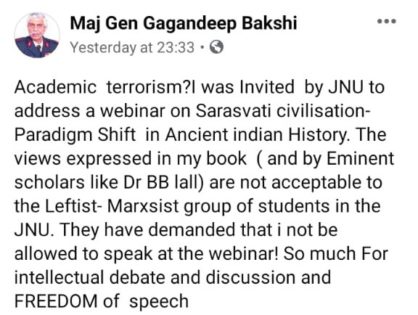
Yes Sarasvati river did exist thousands of years ago. Maj Gen GD Bakshi has been researching on the existence of this Vedic river and has penned a book based on his findings. In his words, “The Sarasvati was the true cradle of the Indic civilisation. The bulk of the Indus valley sites are along the Sarasvati course not on the Indus. The Vedas were received here. Max Muller said the Indo-Aryans had come from Central Asia in 1500 BC. As per geologists by 1900 BC the Sarasvati river had dried out entirely due to tectonic plate shifts. The Sarasvati is described in Rig Veda as the mother of Floods, Roaring river. Greatest of rivers. This is what the river was some 5-6000 years ago. The entire Colonial chronology is wrong. Why would Aryans come to a land where the main river had gone dry. Lack of water forces people to get away, not come in. The Figurines discovered in The Indus- Sarasvati valley have sindoor in their maangs and bindis on their forehead – they wear bangles and necklaces.”
To quote further from Maj Gen GD Bakshi on the objection of his webinar by JNU leftists: “A section of the Leftist students lobby at JNU is very upset about the invitation given to me to speak on Sarasvati Civilisation- A paradigm shift in Indian history. Academic institutions encourage debate and discussion of contrarian viewpoints. I am very surprised to see this blatant attempt to block free speech by people who remind us every day of THEIR right to free speech.
2. I am glad this controversy has arisen because it throws light on a very vital aspect of our Ancient history and very identity as a people.
3. There is a dire need to adopt a multi- disciplinary approach to some of the hotly contested Issues of our ancient history. We had a two day seminar at Delhi university last year. I had also published my book on this topic.
4. A lot of data and new findings have piled up since Max Muller wrote down Ancient Indian histories basic tenets of the Aryan invasion theory etc. today we need to Integrate these new finding with what we know. There is a dire need for a COPENHAGEN style convention (as was held for Quantum mechanics) in the 1930s to evolve a paradigm shift in ancient Indian history. Lets hope the debate in JNU kicksstarts that vital academic process. to OWN our HISTORY and not have it handed down to us by Colonial historians with an agenda of justifying foreign rule.”
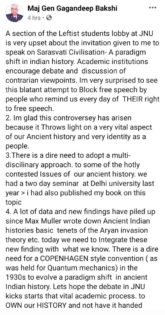
Below is a prologue to the book on the Sarasvati river – The Sarasvati Civilization authored by Maj Gen GD Bakshi:
This is a book about a lost river that once sustained a civilization spread over a vast area of some 2 million sq. kms. It was a mighty river, mightier perhaps than the Brahmaputra. It ran for 4,600 kms from the Himalayas to the Sea. It was in its prime some 5-6,000 years ago. Then around 1,900 B.C.E., it simply vanished due to a combination of tectonic plate shifts and a monotonic weakening of the monsoons.
What is amazing is the way the memory of this once mighty river was preserved for four thousand years in India’s oral traditions and in its scriptures. Most colonial historians deemed it a myth, but the memory of a sacred stream that had vanished was preserved in the racial memory of South Asia with a tenacity that was astonishing. In the 1970s the US sent up its Landsat satellite that beamed back pictures of the dried out course of a once mighty river in North Western India. The river was not a myth anymore. It was now an empirical fact.
Scores of satellites launched by ISRO have confirmed the course of a once mighty river that dominated the civilizational landscape in the Indian subcontinent. It was the cradle river of the Indian civilization. More than 60% of the sites of the so-called Indus Valley civilization were located along the dried out course of the Sarasvati. It was an amazing civilization spread over a vast landmass of some 2 million sq. kms. What has been remarkable is the degree of homogeneity of this vast civilization. Even more surprising is the astonishing degree of cultural continuity that it exhibited with the present day Hindu civilization in North and Western India.
Though the Indus Valley script has still not been deciphered, there were a whole host of terracotta figurines recovered from the Indus- Sarasvati valley sites, that depicted Yoga postures, meditating priests, a Proto Shiva Linga and yoni symbolisms; and the vermilion in the median parting of hair, bindis and bangles and other accoutrements worn by Hindu ladies today. Since the Indus-Sarasvati valley civilization occupied precisely the same geographical area described in the Rig Vedas and other Hindu scriptures – it was natural to ask whether the Harappan civilization and the Rig Vedic Aryan civilization were indeed one and the same.
This however, flew in the face of the trenchant narratives propagated by the colonial historians of British India. Max Mueller and Sir Moritimer Wheeler had decreed that the Indo-Aryans who composed the Rig Veda and laid the foundation of present day Hindu religion, were foreigners. They had come from an Aryan homeland in the Steppes of Central Asia in the Bronze Age (around 1,500 B.C.) and destroyed the indigenous Indus valley civilization with their war chariots and horsed cavalry, which gave them an overwhelming military advantage over the “dark skinned and snub nosed Dravidians” of the Indus Valley tradition. Indra, the Aryan war god,had destroyed a 100 fort cities and committed large scale genocide that drove the poor Dravidians South of the Vindhyas. The Aryans and Dravidians were viewed as racial categories by the colonial historians. This was the celebrated Aryan Invasion Theory (AIT).
The fact however is that not a shred of evidence was ever found to substantiate such a large scale slaughter and genocide. Just 38 skeletons were found at one site and 11 at another. Even these did not bear any mark of swords and spear cuts. It was genocide sans corpses. The AIT was therefore given a quiet burial and deftly replaced by the Indo-Aryan Migration Theory (IAMT). The Aryans had not actually invaded, it was now said. They had just streamed in wave after wave of migrations. A whole new set of evidence from multiple sources now clearly indicates that even this theory was untenable.
Let us examine some of the reasons:-
1. Max Mueller dated the Indo-Aryan advent to 1,500 B.C. He averred that the Aryans came into India and composed the Rig Veda here.
2. The Rig Veda clearly describes the Sarasvati as a mighty river in full and torrential flow. By 1,900 B.C, Geologists tell us that the Sarasvati had dried out entirely. It had been reduced to a string of pools in the North; and South of Jaisalmer it had gone underground. The dessication of this mighty river had led to the total desertification of Rajasthan and the lower portions of Haryana and Punjab.
3. Why would migrants come to an area that was facing an eco-catastrophe of such a magnitude- given that a once mighty river which sustained a great civilization had dried out completely? Deprived of water, the inhabitants of the Sarasvati civilization had no option but to migrate – outwards.
4. How does that square with a wave of migrations that swept in from Central Asia inwards- precisely at that point in time? There are huge inconsistencies in the basic logic here.
5. What is unfortunate is a blatant & deliberate attempt by leftist historians today to foist this AIT down the academic throats of all Indians.
6. Colonial historiography suffered from massive inbuilt racial biases. It was trying to justify foreign rule to a native population. It was hell bent on proving that Aryans were equally foreigners – even as the British were. So they had no right to carp about foreigners from Great Britain coming in to rule India.
7. Colonial historiography tried its best to destroy the very Idea of India as a nation or civilizational state.
8. Its Eurocentric orientation led it to decree that Mesopotamia was the cradle of human civilization. Agriculture had been invented there and spread to the cavemen in India, Iran, Central Asia and Europe.
9. We know that West Asia was the cradle of all three monotheistic, Abrahamic religions. What was disconcerting were the levels of certitude – we are right and the rest of world is wrong attitudes that emanated from here. People from this cradle of global civilization subsequently embarked upon crusades and jihads to kill/convert all non-believers – not the most civilized behavior.
10. There was an unwritten law in the colonial era as it were-nothing could predate this Mesopotamian cradle in terms of antiquity. Hence Max Mueller had designated 1,500 B.C. as the age of advent of the Indo-Aryans.
11. Today, there is a dire need for a multidisciplinary approach to settle the central questions of Indology.
12. Were the Indo-Aryans aliens or indigenous?
13. Where was the mythical Aryan homeland located?
14. Which was the proto Indo-European language that had diffused all over North India, Iran, Central Asia and Europe?
15. What empirical evidence do we have to support the thesis of mass scale human migrations into India in the Bronze Age – when the dessication of the Sarasvati should rightly have triggered a major exodus?
Today, there is an enormous amount of data and evidence that has piled up in multiple fields of enquiry. Satellite imagery, Geological studies of the paleo-channels and Archaeological evidences are piling up to reveal an amazing degree of cultural continuity since the Harappan civilization to the modern day Hindu society in the North Western quadrant of India.
Besides, there are tropes of evidences in the Vedas, Brahmans, Epics and other Indian scriptures. Linguistic studies have thrown up the uncanny similarities in the Sanskrit language and the dialects of Iran, Central Asia and Europe – which point to a proto Indo-European language from which these dialects originated.
This book has therefore adopted a multi-disciplinary approach to address the seminal questions of Ancient Indian History. I have examined the imposed narratives of the colonial historiography to point out the blatant bias and prejudice. The so called Left Wing Liberal Academicians are now trying to outdo their former colonial masters in their zeal to sustain and perpetuate the colonial era myths and spin doctored narratives.All of these had underlying motives and agendas- the primary being to justify foreign rule on a subject population.
The most significant new finding today stems from the rediscovery of the lost Sarasvati River. I have marshaled the remote sensing data provided by satellite imagery to confirm the existence of a once mighty river that flowed from the Himalayas to the Arabian Sea and was the source river and cradle of the Indian civilization per se.I have next examined the voluminous evidence provided by the discipline of Geology to record the vicissitudes in the life and flow of this mighty river and establish the chronology of events that led to its dessication and demise.
The most significant of all findings however, come from the discipline of Archaeology. I have examined the Archaeological studies in considerable detail to understand the true nature and identity of the Indus-Sarasvati Valley civilization. Even though the Indus Valley script has not so far been deciphered – the vast assortment of terracotta figurines, dolls and pictures on tablets and seals provide a graphic visual language so to speak – that provides deep insights into that ancient civilization. What stands out is the sheer level of cultural continuity between the ancient past and present day Hindu society. The evidence of cultural continuity is so overwhelming that it is astonishing to see how deliberately it has been sidelined so far by the Leftist academia.
There are then the tropes of scriptural and linguistic evidences. I have tried to cover each of these aspects in fair detail to adopt a truly multidisciplinary approach to answering the seminal questions and debates in Indology.There is also the exciting new field of DNA mapping studies that is casting a new light on those ancient conundrums. It is my earnest hope that this effort will help to crystallize the historical truth. The mounting weight of evidence in multiple fields is crying out today for a paradigm shift in Indology.What we need urgently is a Copenhagen style convention (that was held to settle the debates in Quantum Physics) now on the subject of Indology. We need to examine in detail the new evidence that has emanated from multiple fields of enquiry.
Responding to this urgent call for a Copenhagen style convention in view of the overwhelming body of new evidence – Delhi University will be organizing a multi- disciplinary seminar on this subject in August 2019. I do hope its findings will be widely discussed and debated in academic circles all over the world.I do hope they will help to settle some of the outstanding issues and questions of ancient Indian history.
Anil Suri has rightly said – “Education and academics must deal in knowledge – not narratives.” What we need to jettison is dogmatism and obscurantism. Ancient Indian History must remain open now to interpretations that stem from fresh research in multiple fields. A multidisciplinary approach is a sine qua non in addressing such complex questions that deal with identity per se.
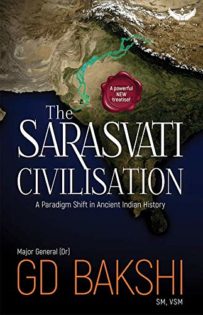
Click here to buy The Sarasvati Civilization.
Featured image courtesy: indiatimes.com and Facebook.

